Comprehensive Analysis of the Australian Dairy Industry Report
VerifiedAdded on 2020/03/01
|20
|3321
|40
Report
AI Summary
This report provides a comprehensive analysis of the Australian dairy industry, examining its domestic and international market positions. It delves into the industry's structure, including internal value chains and regional strengths, while also assessing external factors, challenges, and opportunities. The report explores the international trade scenario, export shares, and the life cycle of milk and its derivatives. Strategic analysis, including Porter’s value chain analysis, is also included. The report concludes with key findings and recommendations for the industry's future.

Running head: THE AUSTRALIAN DAIRY INDUSTRY
Australian Dairy Industry analysis
Name of the Student:
Name of the University:
Author note:
Australian Dairy Industry analysis
Name of the Student:
Name of the University:
Author note:
Paraphrase This Document
Need a fresh take? Get an instant paraphrase of this document with our AI Paraphraser
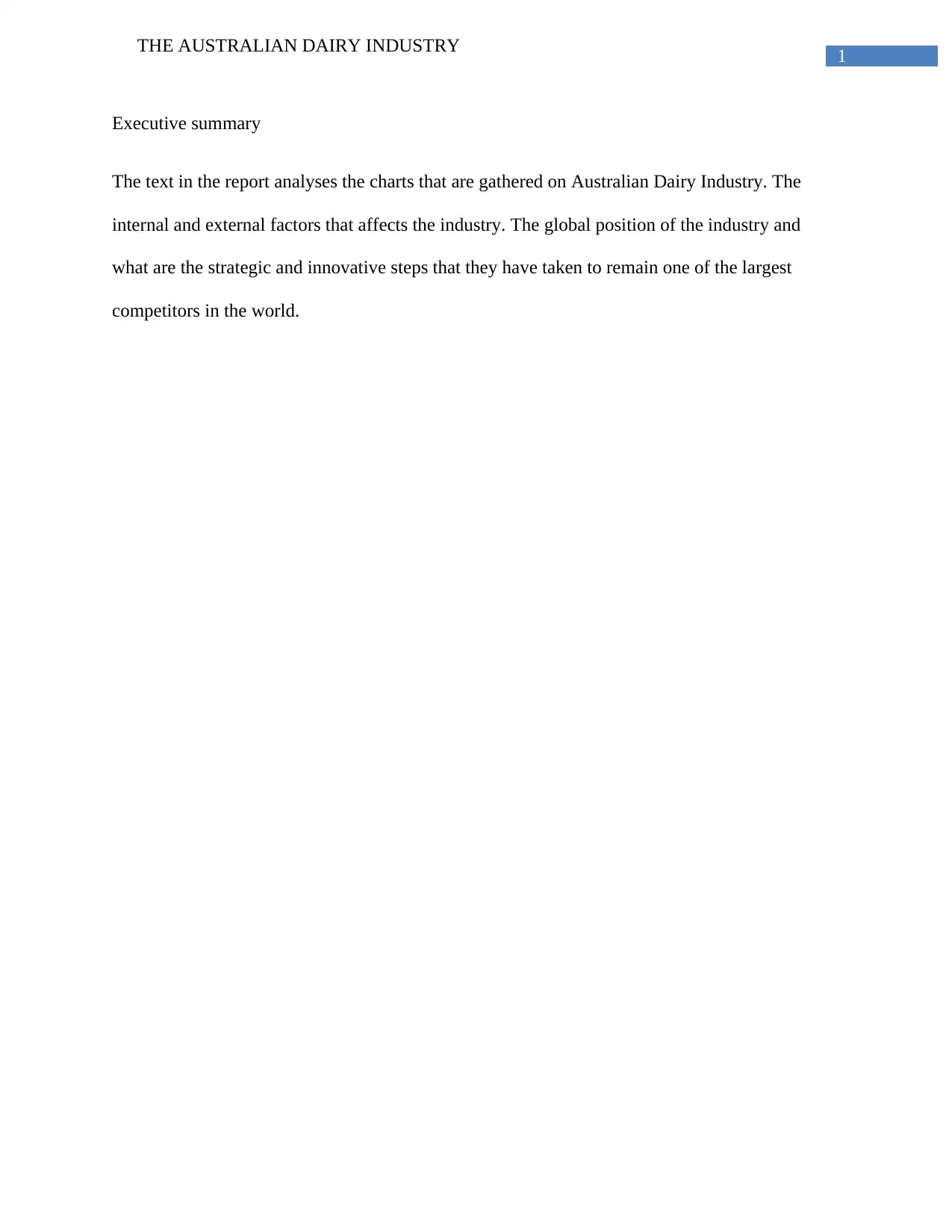
1
THE AUSTRALIAN DAIRY INDUSTRY
Executive summary
The text in the report analyses the charts that are gathered on Australian Dairy Industry. The
internal and external factors that affects the industry. The global position of the industry and
what are the strategic and innovative steps that they have taken to remain one of the largest
competitors in the world.
THE AUSTRALIAN DAIRY INDUSTRY
Executive summary
The text in the report analyses the charts that are gathered on Australian Dairy Industry. The
internal and external factors that affects the industry. The global position of the industry and
what are the strategic and innovative steps that they have taken to remain one of the largest
competitors in the world.
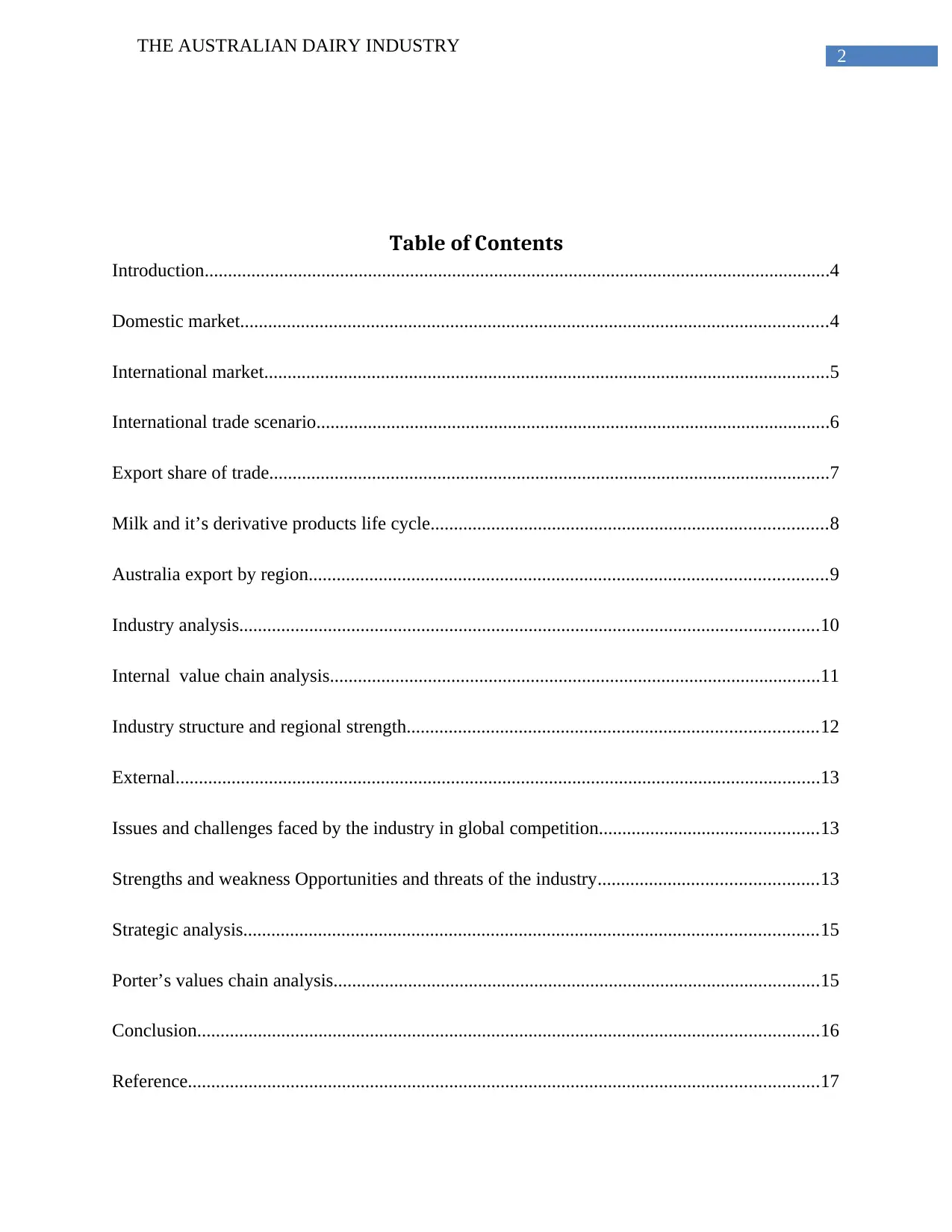
2
THE AUSTRALIAN DAIRY INDUSTRY
Table of Contents
Introduction......................................................................................................................................4
Domestic market..............................................................................................................................4
International market.........................................................................................................................5
International trade scenario..............................................................................................................6
Export share of trade........................................................................................................................7
Milk and it’s derivative products life cycle.....................................................................................8
Australia export by region...............................................................................................................9
Industry analysis............................................................................................................................10
Internal value chain analysis.........................................................................................................11
Industry structure and regional strength........................................................................................12
External..........................................................................................................................................13
Issues and challenges faced by the industry in global competition...............................................13
Strengths and weakness Opportunities and threats of the industry...............................................13
Strategic analysis...........................................................................................................................15
Porter’s values chain analysis........................................................................................................15
Conclusion.....................................................................................................................................16
Reference.......................................................................................................................................17
THE AUSTRALIAN DAIRY INDUSTRY
Table of Contents
Introduction......................................................................................................................................4
Domestic market..............................................................................................................................4
International market.........................................................................................................................5
International trade scenario..............................................................................................................6
Export share of trade........................................................................................................................7
Milk and it’s derivative products life cycle.....................................................................................8
Australia export by region...............................................................................................................9
Industry analysis............................................................................................................................10
Internal value chain analysis.........................................................................................................11
Industry structure and regional strength........................................................................................12
External..........................................................................................................................................13
Issues and challenges faced by the industry in global competition...............................................13
Strengths and weakness Opportunities and threats of the industry...............................................13
Strategic analysis...........................................................................................................................15
Porter’s values chain analysis........................................................................................................15
Conclusion.....................................................................................................................................16
Reference.......................................................................................................................................17
⊘ This is a preview!⊘
Do you want full access?
Subscribe today to unlock all pages.

Trusted by 1+ million students worldwide
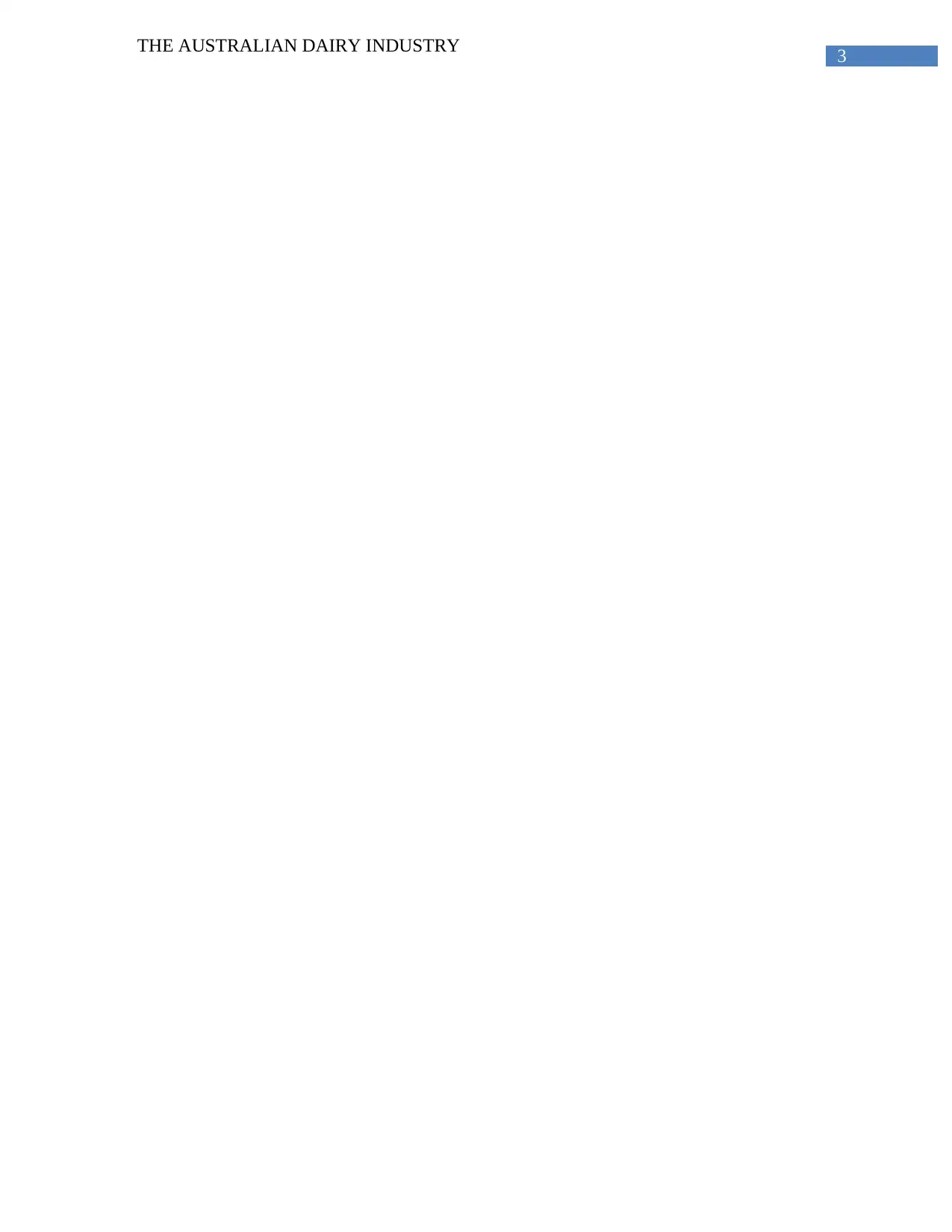
3
THE AUSTRALIAN DAIRY INDUSTRY
THE AUSTRALIAN DAIRY INDUSTRY
Paraphrase This Document
Need a fresh take? Get an instant paraphrase of this document with our AI Paraphraser

4
THE AUSTRALIAN DAIRY INDUSTRY
Introduction
Australian industry is one of the most agriculture intensive industries comparing with the
global agriculture market. Victoria is dominant in dairy and herd production. The evolution o f
technology has served them well and their productivity has increased since last three decades
(Klerkx and Nettle, 2013). The small farmers were able to generate the derivative products of
milk and supported to the revenue that every individual state made in the following years.
According to the dairy situation and outlook report on 2017 the farmers have produced 700
million fewer litters of milk due to a huge crisis that have hit the whole Australia in the last year
(Sorensen, 2011). However, the consumption of the branded products has not lessened. Victoria
being the centre of production has seen 9% growth in the full cream milk production (Klerkx and
Nettle, 2013). Whereas Australia accounts for an approximate 2% of the world’s milk
production, it is a noteworthy exporter of dairy merchandise (Regulations, 2013). The Australian
dairy industry was significantly challenged by deregulation, droughts and the financial crisis.
However, the industry has also been seen to to adapt to difficult situations through sharing its
view of the challenges and opportunities and with collective action. One crucial feature for their
success now would be the policy control of the environmental factors, which is an important role
in accordance with the industry to adapt in the future and further develop.
Domestic market
The Australian Dairy industry is a fully established industry and some subtropical areas
of Australia is also rich in giving supply to its customers. Even though most of the country’s
milk production takes place in south‐east seaboard parts states, all states have separate dairy
farms that supply fresh drinking milk to close by cities and towns.
THE AUSTRALIAN DAIRY INDUSTRY
Introduction
Australian industry is one of the most agriculture intensive industries comparing with the
global agriculture market. Victoria is dominant in dairy and herd production. The evolution o f
technology has served them well and their productivity has increased since last three decades
(Klerkx and Nettle, 2013). The small farmers were able to generate the derivative products of
milk and supported to the revenue that every individual state made in the following years.
According to the dairy situation and outlook report on 2017 the farmers have produced 700
million fewer litters of milk due to a huge crisis that have hit the whole Australia in the last year
(Sorensen, 2011). However, the consumption of the branded products has not lessened. Victoria
being the centre of production has seen 9% growth in the full cream milk production (Klerkx and
Nettle, 2013). Whereas Australia accounts for an approximate 2% of the world’s milk
production, it is a noteworthy exporter of dairy merchandise (Regulations, 2013). The Australian
dairy industry was significantly challenged by deregulation, droughts and the financial crisis.
However, the industry has also been seen to to adapt to difficult situations through sharing its
view of the challenges and opportunities and with collective action. One crucial feature for their
success now would be the policy control of the environmental factors, which is an important role
in accordance with the industry to adapt in the future and further develop.
Domestic market
The Australian Dairy industry is a fully established industry and some subtropical areas
of Australia is also rich in giving supply to its customers. Even though most of the country’s
milk production takes place in south‐east seaboard parts states, all states have separate dairy
farms that supply fresh drinking milk to close by cities and towns.

5
THE AUSTRALIAN DAIRY INDUSTRY
Australian milk production has been steadily increasing with the demand and modified derivative
product of milk. Fresh milk, butter, cheese, milk powders, whey products and casein (Sorensen,
2011).
International market
The New Zealand statistics shows that, they are one among the key industries in the dairy
production (Klerkx and Nettle, 2013). The organization is able to satisfy the thirst of the country
and whole world’s demand of milk and its side products. The small shelf life of milk means that
Australia’s export percentage of fresh milk is partial mainly to UHT product. Around 80% of
Australia’s fresh milk exports goes to Asia with a further 15% intended for the Pacific region
(Regulations, 2013). The cheese industry itself exports to 50% of the domestic production. This
industry itself is a predominantly developed in the national region. The Skimmed milk powder
and the whole milk powder accounts to 80% of the
National dairy herd 1.6 million
Average herd size 220 cows
National milk production 9 billion litres
Dairy workforce 40,000*2.5
Figure: Australian consumption statistics(Australian-dairy-industry, 2017)
THE AUSTRALIAN DAIRY INDUSTRY
Australian milk production has been steadily increasing with the demand and modified derivative
product of milk. Fresh milk, butter, cheese, milk powders, whey products and casein (Sorensen,
2011).
International market
The New Zealand statistics shows that, they are one among the key industries in the dairy
production (Klerkx and Nettle, 2013). The organization is able to satisfy the thirst of the country
and whole world’s demand of milk and its side products. The small shelf life of milk means that
Australia’s export percentage of fresh milk is partial mainly to UHT product. Around 80% of
Australia’s fresh milk exports goes to Asia with a further 15% intended for the Pacific region
(Regulations, 2013). The cheese industry itself exports to 50% of the domestic production. This
industry itself is a predominantly developed in the national region. The Skimmed milk powder
and the whole milk powder accounts to 80% of the
National dairy herd 1.6 million
Average herd size 220 cows
National milk production 9 billion litres
Dairy workforce 40,000*2.5
Figure: Australian consumption statistics(Australian-dairy-industry, 2017)
⊘ This is a preview!⊘
Do you want full access?
Subscribe today to unlock all pages.

Trusted by 1+ million students worldwide
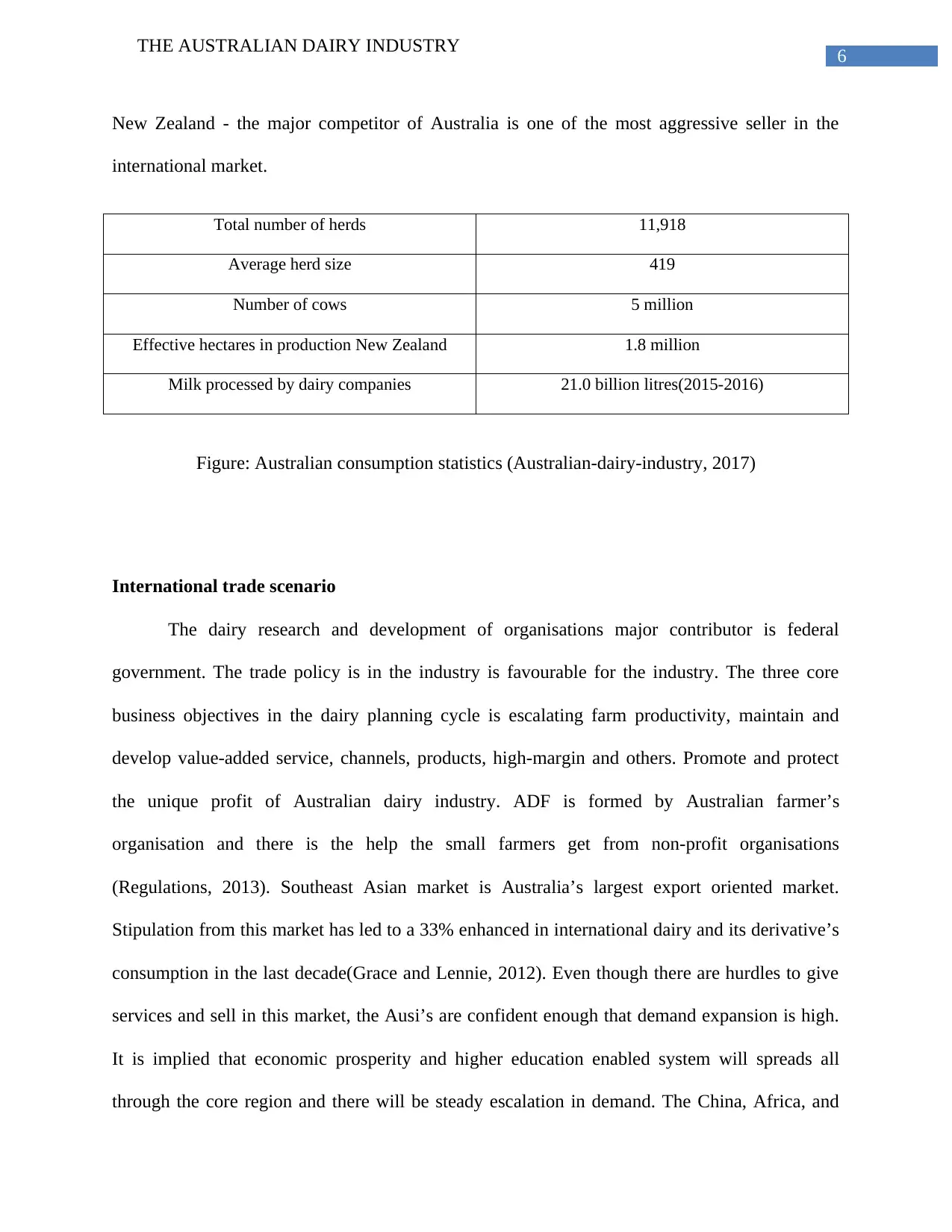
6
THE AUSTRALIAN DAIRY INDUSTRY
New Zealand - the major competitor of Australia is one of the most aggressive seller in the
international market.
Total number of herds 11,918
Average herd size 419
Number of cows 5 million
Effective hectares in production New Zealand 1.8 million
Milk processed by dairy companies 21.0 billion litres(2015-2016)
Figure: Australian consumption statistics (Australian-dairy-industry, 2017)
International trade scenario
The dairy research and development of organisations major contributor is federal
government. The trade policy is in the industry is favourable for the industry. The three core
business objectives in the dairy planning cycle is escalating farm productivity, maintain and
develop value-added service, channels, products, high-margin and others. Promote and protect
the unique profit of Australian dairy industry. ADF is formed by Australian farmer’s
organisation and there is the help the small farmers get from non-profit organisations
(Regulations, 2013). Southeast Asian market is Australia’s largest export oriented market.
Stipulation from this market has led to a 33% enhanced in international dairy and its derivative’s
consumption in the last decade(Grace and Lennie, 2012). Even though there are hurdles to give
services and sell in this market, the Ausi’s are confident enough that demand expansion is high.
It is implied that economic prosperity and higher education enabled system will spreads all
through the core region and there will be steady escalation in demand. The China, Africa, and
THE AUSTRALIAN DAIRY INDUSTRY
New Zealand - the major competitor of Australia is one of the most aggressive seller in the
international market.
Total number of herds 11,918
Average herd size 419
Number of cows 5 million
Effective hectares in production New Zealand 1.8 million
Milk processed by dairy companies 21.0 billion litres(2015-2016)
Figure: Australian consumption statistics (Australian-dairy-industry, 2017)
International trade scenario
The dairy research and development of organisations major contributor is federal
government. The trade policy is in the industry is favourable for the industry. The three core
business objectives in the dairy planning cycle is escalating farm productivity, maintain and
develop value-added service, channels, products, high-margin and others. Promote and protect
the unique profit of Australian dairy industry. ADF is formed by Australian farmer’s
organisation and there is the help the small farmers get from non-profit organisations
(Regulations, 2013). Southeast Asian market is Australia’s largest export oriented market.
Stipulation from this market has led to a 33% enhanced in international dairy and its derivative’s
consumption in the last decade(Grace and Lennie, 2012). Even though there are hurdles to give
services and sell in this market, the Ausi’s are confident enough that demand expansion is high.
It is implied that economic prosperity and higher education enabled system will spreads all
through the core region and there will be steady escalation in demand. The China, Africa, and
Paraphrase This Document
Need a fresh take? Get an instant paraphrase of this document with our AI Paraphraser

7
THE AUSTRALIAN DAIRY INDUSTRY
Middle East are the one among the major exporters of the dairy products and consume the major
percentage of the products (Grace and Lennie, 2012).
The Australian market has strength in the domestic market and furthermore, they are
milk’s multinational value increment (Sorensen, 2011). The derivatives of the main product are
also capturing the completely international market competing with the value-addition and
prospective consumption market percentage (Nettle, Paine and Penry, 2010).
However, the trade regulations of the industry have to face some highly contingency
factors. This includes the China and Middle East’s production and expansion in the regarding
instruction (Nettle, Paine and Penry, 2010). The Neighbouring countries production and their
strong economic condition can be highly competitive in the recent years inferred from the above
table. European’s balance and protectionist has long since given headache to the trade enablers in
the international market. Their products are facing headed competition with the former dairy
market leaders (Grace and Lennie, 2012). The prices of the products are also volatile because of
dynamic supply-demand ration working in the industry.
Export share of trade
EU 32%
New Zealand 35%
Australia 10%
USA 7%
Argentina 4%
Ukraine 2%
Uruguay 1%
THE AUSTRALIAN DAIRY INDUSTRY
Middle East are the one among the major exporters of the dairy products and consume the major
percentage of the products (Grace and Lennie, 2012).
The Australian market has strength in the domestic market and furthermore, they are
milk’s multinational value increment (Sorensen, 2011). The derivatives of the main product are
also capturing the completely international market competing with the value-addition and
prospective consumption market percentage (Nettle, Paine and Penry, 2010).
However, the trade regulations of the industry have to face some highly contingency
factors. This includes the China and Middle East’s production and expansion in the regarding
instruction (Nettle, Paine and Penry, 2010). The Neighbouring countries production and their
strong economic condition can be highly competitive in the recent years inferred from the above
table. European’s balance and protectionist has long since given headache to the trade enablers in
the international market. Their products are facing headed competition with the former dairy
market leaders (Grace and Lennie, 2012). The prices of the products are also volatile because of
dynamic supply-demand ration working in the industry.
Export share of trade
EU 32%
New Zealand 35%
Australia 10%
USA 7%
Argentina 4%
Ukraine 2%
Uruguay 1%
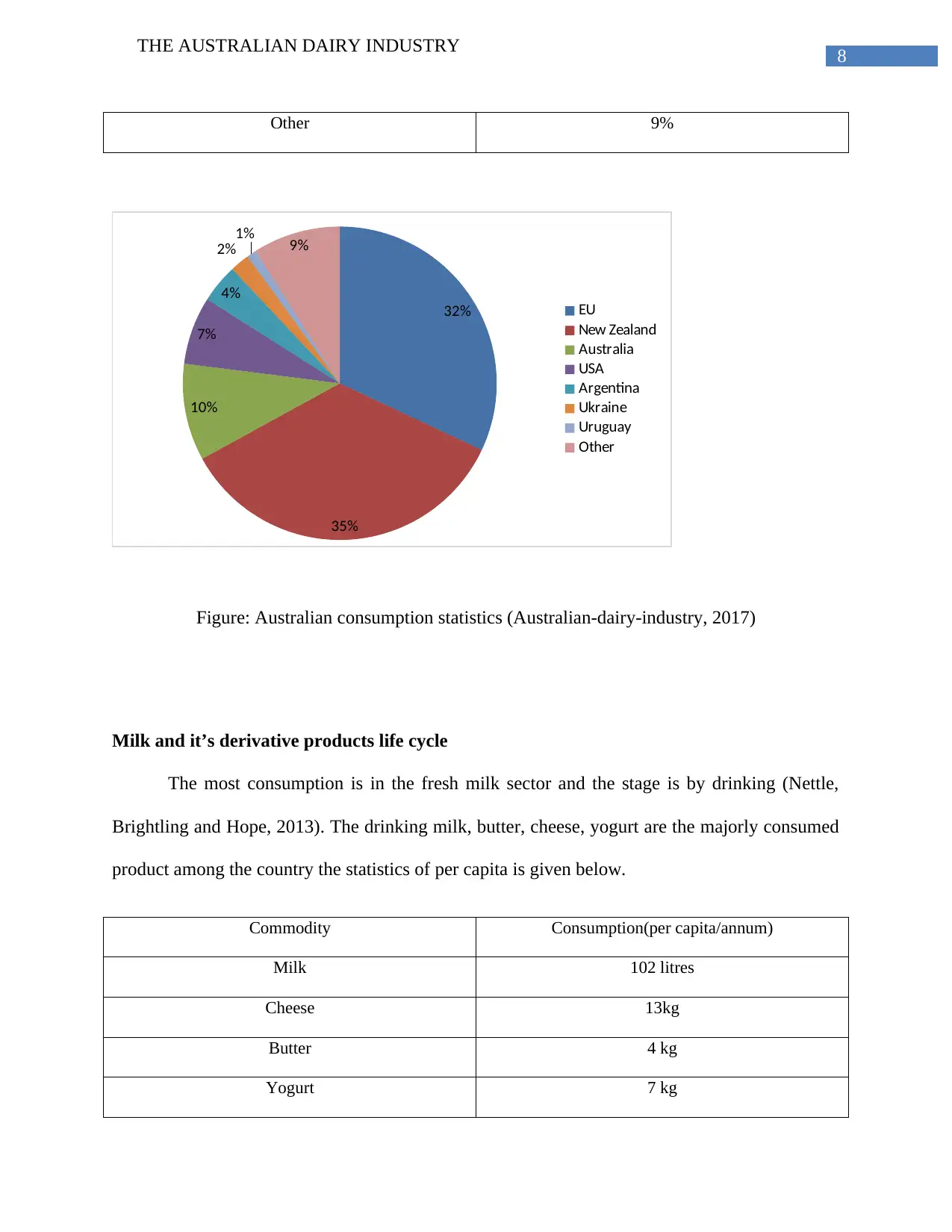
8
THE AUSTRALIAN DAIRY INDUSTRY
Other 9%
32%
35%
10%
7%
4%
2%1% 9%
EU
New Zealand
Australia
USA
Argentina
Ukraine
Uruguay
Other
Figure: Australian consumption statistics (Australian-dairy-industry, 2017)
Milk and it’s derivative products life cycle
The most consumption is in the fresh milk sector and the stage is by drinking (Nettle,
Brightling and Hope, 2013). The drinking milk, butter, cheese, yogurt are the majorly consumed
product among the country the statistics of per capita is given below.
Commodity Consumption(per capita/annum)
Milk 102 litres
Cheese 13kg
Butter 4 kg
Yogurt 7 kg
THE AUSTRALIAN DAIRY INDUSTRY
Other 9%
32%
35%
10%
7%
4%
2%1% 9%
EU
New Zealand
Australia
USA
Argentina
Ukraine
Uruguay
Other
Figure: Australian consumption statistics (Australian-dairy-industry, 2017)
Milk and it’s derivative products life cycle
The most consumption is in the fresh milk sector and the stage is by drinking (Nettle,
Brightling and Hope, 2013). The drinking milk, butter, cheese, yogurt are the majorly consumed
product among the country the statistics of per capita is given below.
Commodity Consumption(per capita/annum)
Milk 102 litres
Cheese 13kg
Butter 4 kg
Yogurt 7 kg
⊘ This is a preview!⊘
Do you want full access?
Subscribe today to unlock all pages.

Trusted by 1+ million students worldwide
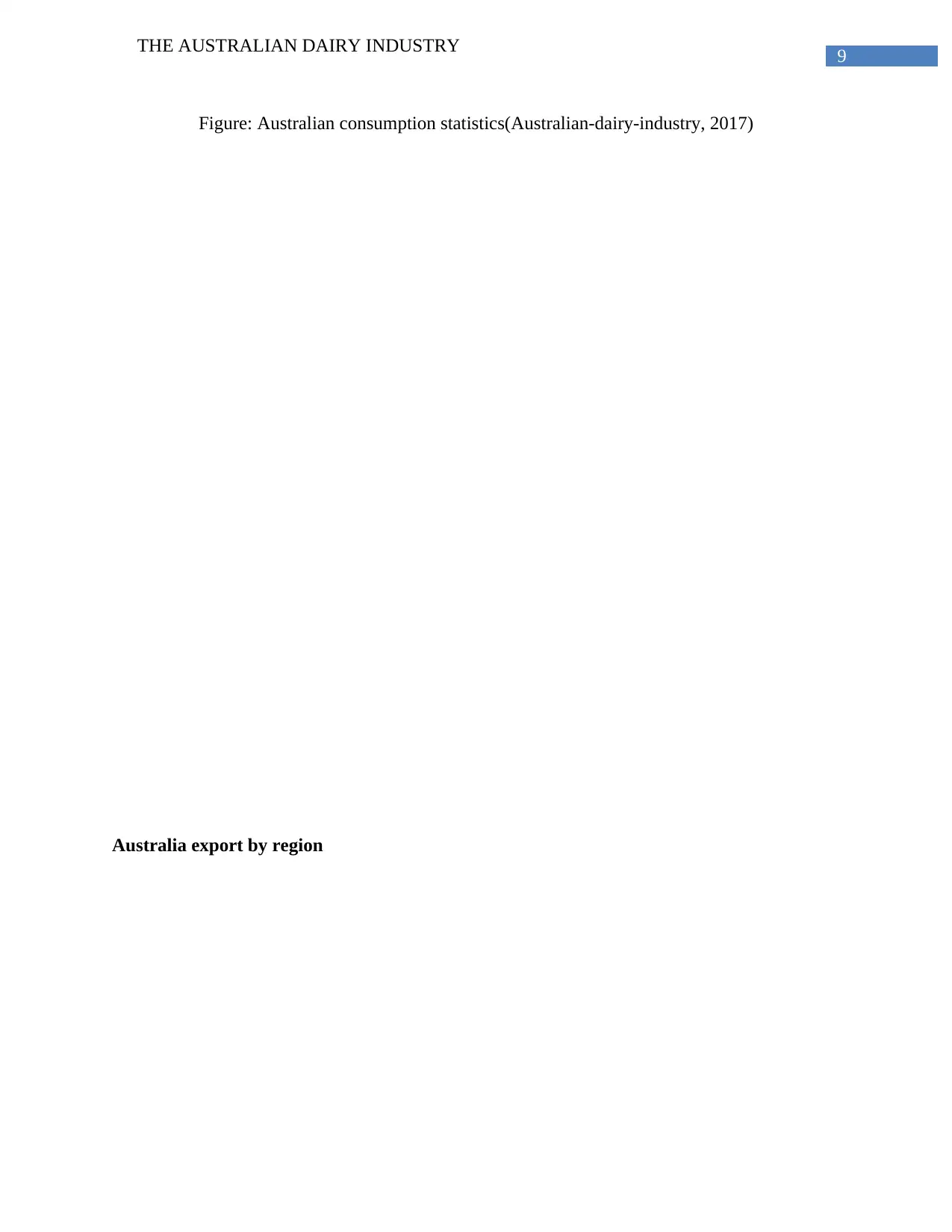
9
THE AUSTRALIAN DAIRY INDUSTRY
Figure: Australian consumption statistics(Australian-dairy-industry, 2017)
Australia export by region
THE AUSTRALIAN DAIRY INDUSTRY
Figure: Australian consumption statistics(Australian-dairy-industry, 2017)
Australia export by region
Paraphrase This Document
Need a fresh take? Get an instant paraphrase of this document with our AI Paraphraser

10
THE AUSTRALIAN DAIRY INDUSTRY
South
East Asia Japan America Africa Middle
east Europe Other
Asia
0%
5%
10%
15%
20%
25%
30%
35%
30%
19%
5% 4%
10%
2%
24%
Series1
South East Asia 30%
Japan 19%
America 5%
Africa 4%
Middle east 10%
Europe 2%
Other Asia 24%
Figure: Australia export by region Australia (Abs.gov.au, 2017)
Industry analysis
Competition
THE AUSTRALIAN DAIRY INDUSTRY
South
East Asia Japan America Africa Middle
east Europe Other
Asia
0%
5%
10%
15%
20%
25%
30%
35%
30%
19%
5% 4%
10%
2%
24%
Series1
South East Asia 30%
Japan 19%
America 5%
Africa 4%
Middle east 10%
Europe 2%
Other Asia 24%
Figure: Australia export by region Australia (Abs.gov.au, 2017)
Industry analysis
Competition
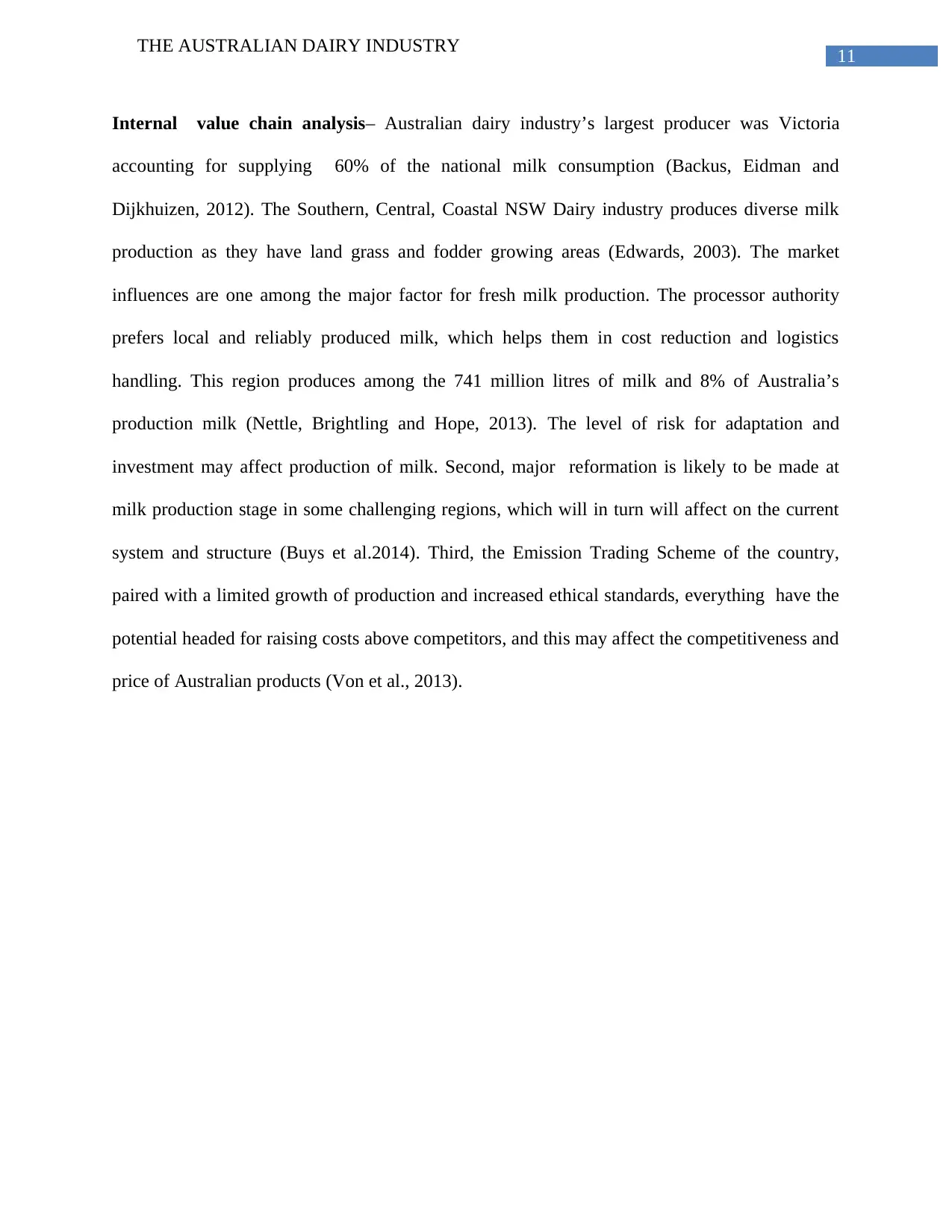
11
THE AUSTRALIAN DAIRY INDUSTRY
Internal value chain analysis– Australian dairy industry’s largest producer was Victoria
accounting for supplying 60% of the national milk consumption (Backus, Eidman and
Dijkhuizen, 2012). The Southern, Central, Coastal NSW Dairy industry produces diverse milk
production as they have land grass and fodder growing areas (Edwards, 2003). The market
influences are one among the major factor for fresh milk production. The processor authority
prefers local and reliably produced milk, which helps them in cost reduction and logistics
handling. This region produces among the 741 million litres of milk and 8% of Australia’s
production milk (Nettle, Brightling and Hope, 2013). The level of risk for adaptation and
investment may affect production of milk. Second, major reformation is likely to be made at
milk production stage in some challenging regions, which will in turn will affect on the current
system and structure (Buys et al.2014). Third, the Emission Trading Scheme of the country,
paired with a limited growth of production and increased ethical standards, everything have the
potential headed for raising costs above competitors, and this may affect the competitiveness and
price of Australian products (Von et al., 2013).
THE AUSTRALIAN DAIRY INDUSTRY
Internal value chain analysis– Australian dairy industry’s largest producer was Victoria
accounting for supplying 60% of the national milk consumption (Backus, Eidman and
Dijkhuizen, 2012). The Southern, Central, Coastal NSW Dairy industry produces diverse milk
production as they have land grass and fodder growing areas (Edwards, 2003). The market
influences are one among the major factor for fresh milk production. The processor authority
prefers local and reliably produced milk, which helps them in cost reduction and logistics
handling. This region produces among the 741 million litres of milk and 8% of Australia’s
production milk (Nettle, Brightling and Hope, 2013). The level of risk for adaptation and
investment may affect production of milk. Second, major reformation is likely to be made at
milk production stage in some challenging regions, which will in turn will affect on the current
system and structure (Buys et al.2014). Third, the Emission Trading Scheme of the country,
paired with a limited growth of production and increased ethical standards, everything have the
potential headed for raising costs above competitors, and this may affect the competitiveness and
price of Australian products (Von et al., 2013).
⊘ This is a preview!⊘
Do you want full access?
Subscribe today to unlock all pages.

Trusted by 1+ million students worldwide
1 out of 20
Related Documents
Your All-in-One AI-Powered Toolkit for Academic Success.
+13062052269
info@desklib.com
Available 24*7 on WhatsApp / Email
![[object Object]](/_next/static/media/star-bottom.7253800d.svg)
Unlock your academic potential
Copyright © 2020–2025 A2Z Services. All Rights Reserved. Developed and managed by ZUCOL.





